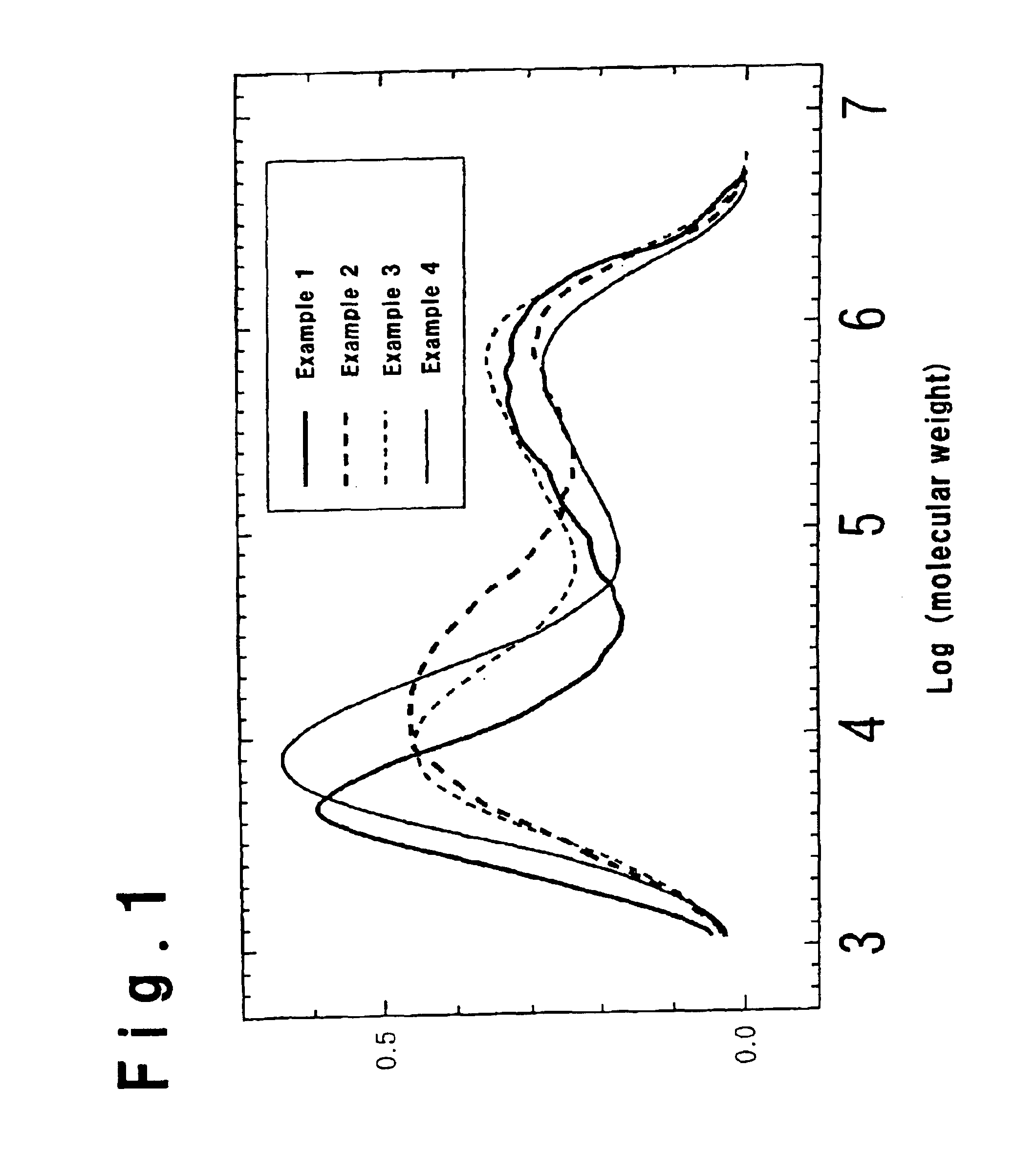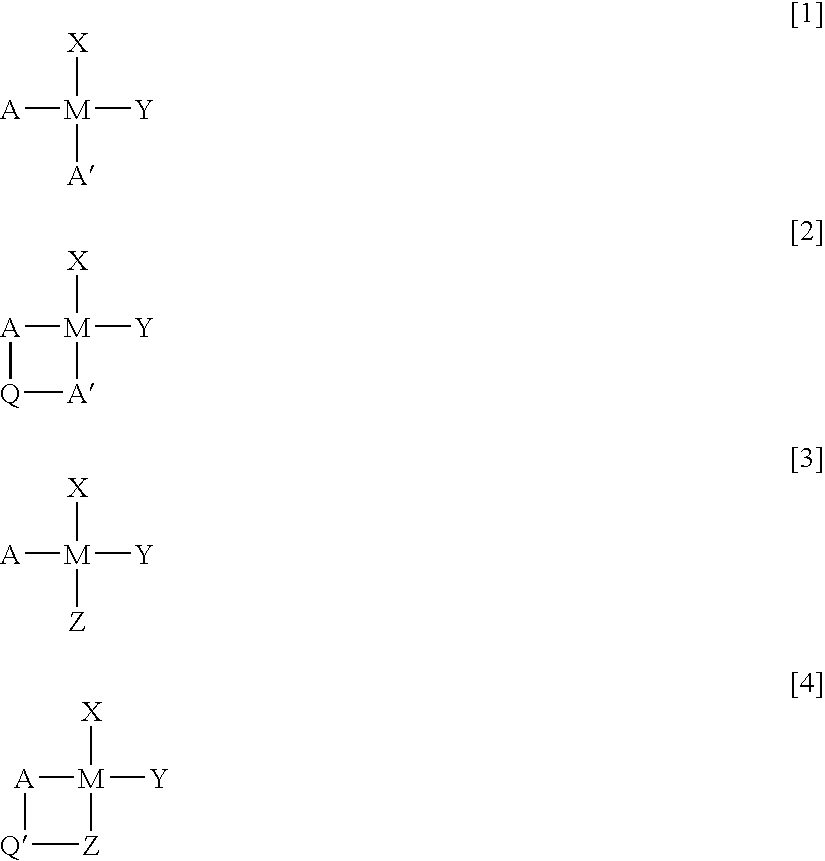Ethylene polymers
a technology of ethylene polymer and ethylene polymer, which is applied in the field of ethylene polymers, can solve the problems of no ethylene polymer having both excellent mechanical properties and molding processability at a high level has been obtained, and achieves excellent molding processability and mechanical characteristics, and the rigidity represented by flexural modulus and escr is unprecedentedly excellen
- Summary
- Abstract
- Description
- Claims
- Application Information
AI Technical Summary
Benefits of technology
Problems solved by technology
Method used
Image
Examples
example 1
(1) Chemical Treatment and Granulation of Clay Mineral
[0174]8 kg of commercially available montmorillonite (“Kunipia F”, manufactured by Kunimine Industries Co., Ltd.) was pulverized by a vibrating ball mill and dispersed in 50 L of demineralized water having 10 kg of magnesium chloride dissolved therein, followed by stirring at 80° C. for 1 hour. The obtained solid component was washed with water, then dispersed in 56 L of a 8.2% hydrochloric acid aqueous solution, followed by stirring at 90° C. for 2 hours and washing with demineralized water. 4.6 kg of a water slurry liquid of montmorillonite thus chemically treated was adjusted to a solid content concentration of 15.2%, and subjected to spray drying by a spray dryer. The shape of particles obtained by granulation was spherical shape.
(2) Chromium Salt Treatment of Clay Mineral
[0175]80 g of commercially available Cr(NO3)3.9H2O was dissolved in 1000 g of pure water, then 200 g of the chemically treated montmorillonite granulated pa...
example 2
(1) Catalyst Preparation and Preliminary Polymerization
[0181]Catalyst preparation and preliminary polymerization were carried out in the same manner as in Example 1 (1) to (4), except that 1.601 mmol (0.468 g) of bis(cyclopentadienyl)zirconium dichloride was used based on 9.15 g of the dry montmorillonite particles treated with chromium salt, and the amount of triethylaluminum used at the time of preliminary polymerization was 19.18 mmol (2.19 g). As a result, 79.39 g of a preliminarily polymerized catalyst powder was recovered.
(2) Polymerization of Ethylene
[0182]Ethylene polymerization was carried out by using the preliminarily polymerized catalyst of the above (1) in the same manner as in Example 1 (5), except that 80 mmol of triethylaluminum was used, and the polymerization time was 3 hours. The transition of the hydrogen / ethylene ratio (mol %) at the vapor phase part in the reactor from initiation of the polymerization every 30 minutes was 1.091 / 0.932 / 0.221 / 0.269 / 0.056 / 0.329 / 0.3...
example 3
(1) Polymerization of Ethylene
[0184]Ethylene polymerization was carried out by using the preliminarily polymerized catalyst of Example 2 (1) in the same manner as in Example 2 (2), except that the amount of hydrogen introduced to the reactor before the polymerization was reduced (pressure: 15.0 kg / cm2, volume: 1090 ml), and the polymerization time was 5 hours. The transition of the hydrogen / ethylene ratio (mol %) at the vapor phase part in the reactor after initiation of the polymerization every 30 minutes was 0.830 / 0.685 / 0.418 / 0.421 / 0.201 / 0.463 / 0.224 / 0.418 / 0.210 / 0.411 / 0.203. As a result, 9.9 kg of a particulate ethylene homopolymer was obtained.
[0185]To 100 parts by weight of the obtained polyethylene, 0.1 part by weight of IRGANOX 1010 (trade name, manufactured by Ciba Specialty Chemicals) as a hindered phenol type stabilizer, 0.05 part by weight of IRGAFOS 168 (trade name, manufactured by Ciba Specialty Chemicals) as a phosphite type stabilizer and 0.1 part by weight of calcium s...
PUM
| Property | Measurement | Unit |
|---|---|---|
| melt index | aaaaa | aaaaa |
| flexural modulus | aaaaa | aaaaa |
| temperature | aaaaa | aaaaa |
Abstract
Description
Claims
Application Information
 Login to View More
Login to View More - R&D
- Intellectual Property
- Life Sciences
- Materials
- Tech Scout
- Unparalleled Data Quality
- Higher Quality Content
- 60% Fewer Hallucinations
Browse by: Latest US Patents, China's latest patents, Technical Efficacy Thesaurus, Application Domain, Technology Topic, Popular Technical Reports.
© 2025 PatSnap. All rights reserved.Legal|Privacy policy|Modern Slavery Act Transparency Statement|Sitemap|About US| Contact US: help@patsnap.com


